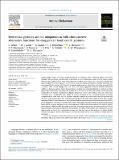Files in this item
Referential gestures are not ubiquitous in wild chimpanzees : alternative functions for exaggerated loud scratch gestures
Item metadata
| dc.contributor.author | Wilke, C. | |
| dc.contributor.author | Lahiff, N.J. | |
| dc.contributor.author | Badihi, G. | |
| dc.contributor.author | Donnellan, E. | |
| dc.contributor.author | Hobaiter, C. | |
| dc.contributor.author | Machanda, Z.P. | |
| dc.contributor.author | Mundry, R. | |
| dc.contributor.author | Pika, S. | |
| dc.contributor.author | Soldati, A. | |
| dc.contributor.author | Wrangham, R.W. | |
| dc.contributor.author | Zuberbűhler, K. | |
| dc.contributor.author | Slocombe, K.E. | |
| dc.date.accessioned | 2022-05-17T11:30:16Z | |
| dc.date.available | 2022-05-17T11:30:16Z | |
| dc.date.issued | 2022-07 | |
| dc.identifier | 279629312 | |
| dc.identifier | b8e44900-b52c-42be-b4e7-a1d8ec53c23e | |
| dc.identifier | 85130356563 | |
| dc.identifier | 000808609900003 | |
| dc.identifier.citation | Wilke , C , Lahiff , N J , Badihi , G , Donnellan , E , Hobaiter , C , Machanda , Z P , Mundry , R , Pika , S , Soldati , A , Wrangham , R W , Zuberbűhler , K & Slocombe , K E 2022 , ' Referential gestures are not ubiquitous in wild chimpanzees : alternative functions for exaggerated loud scratch gestures ' , Animal Behaviour , vol. 189 , pp. 23-45 . https://doi.org/10.1016/j.anbehav.2022.04.007 | en |
| dc.identifier.issn | 0003-3472 | |
| dc.identifier.other | RIS: urn:57D39CEEE3BE8EFBBCFCDC795FF87A11 | |
| dc.identifier.other | ORCID: /0000-0001-8378-088X/work/113398459 | |
| dc.identifier.other | ORCID: /0000-0002-3893-0524/work/113398648 | |
| dc.identifier.uri | https://hdl.handle.net/10023/25390 | |
| dc.description | Royal Zoological Society of Scotland for providing core funding for Budongo Conservation Field Station. This work was supported by the ERC grant awarded to KS (ERC_CoG 2016_724608). | en |
| dc.description.abstract | A fundamental aspect of human communication is our ability to refer to external objects and events through both words and gestures (such as pointing), yet the evolutionary origins of such signals remain obscure. Apes, living in their natural environments, rarely or never point, but it has been claimed that male chimpanzees, Pan troglodytes schweinfurthii, from the Ngogo community, Uganda, habitually use exaggerated loud scratches (ELSs) to refer to specific body locations where they wish to be groomed (Pika & Mitani, 2006, Current Biology, 16(6), 191–192). This study suggested continuity between referential abilities in humans and our closest living relatives, making it an important finding to replicate in other populations. Hence here, we compared whether ELSs are used in a referential manner across four wild communities of eastern chimpanzees (Ngogo, Kanyawara, Sonso and Waibira). Our data show that scratchers were significantly more likely to receive grooming in the scratched location at Ngogo compared to the other three sites. At the latter sites this response occurred at low rates and signallers did not seem to pursue this goal. This suggests that ELSs do not function referentially at these sites, and the published findings from Ngogo were not replicated. Further exploration into alternative functions of ELSs in the Kanyawara community revealed that, in this community, this signal functions to initiate grooming bouts and to reengage partners during grooming pauses. Individuals who produced the signal to initiate grooming were likely to offer grooming. In contrast, during grooming bouts, groomers produced ELSs to request reciprocation of grooming from their partner. Our study demonstrates that chimpanzees do not ubiquitously use the ELS in a referential manner, but that they can use this gesture in a highly flexible fashion, with signal function depending on the intricate details of the social contexts in which they are produced. | |
| dc.format.extent | 23 | |
| dc.format.extent | 1066612 | |
| dc.language.iso | eng | |
| dc.relation.ispartof | Animal Behaviour | en |
| dc.subject | Chimpanzee | en |
| dc.subject | Communication | en |
| dc.subject | Cooperation | en |
| dc.subject | Cultural variation | en |
| dc.subject | Gesture | en |
| dc.subject | Grooming | en |
| dc.subject | Referential signal | en |
| dc.subject | Scratching | en |
| dc.subject | BF Psychology | en |
| dc.subject | QL Zoology | en |
| dc.subject | NDAS | en |
| dc.subject.lcc | BF | en |
| dc.subject.lcc | QL | en |
| dc.title | Referential gestures are not ubiquitous in wild chimpanzees : alternative functions for exaggerated loud scratch gestures | en |
| dc.type | Journal article | en |
| dc.contributor.institution | University of St Andrews. School of Psychology and Neuroscience | en |
| dc.contributor.institution | University of St Andrews. Centre for Social Learning & Cognitive Evolution | en |
| dc.contributor.institution | University of St Andrews. Institute of Behavioural and Neural Sciences | en |
| dc.identifier.doi | https://doi.org/10.1016/j.anbehav.2022.04.007 | |
| dc.description.status | Peer reviewed | en |
This item appears in the following Collection(s)
Items in the St Andrews Research Repository are protected by copyright, with all rights reserved, unless otherwise indicated.

